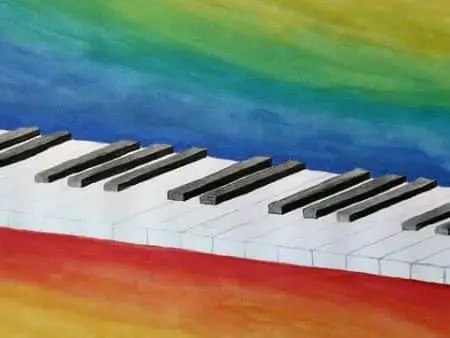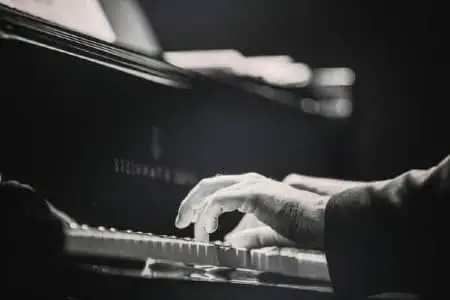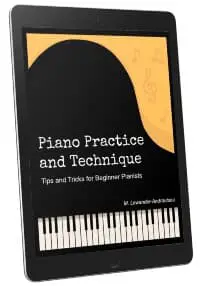- Home
- Piano Scales
- The C Major Scale
Master the C Major Scale for Piano
This article may contain compensated links. Please read the disclosure for more info.
The C major scale is said to be the easiest piano scale to learn first, since it uses only white keys on the piano.
But how is it built, what fingering should you use and what is the best way to practice it? Learn all about it here!
Learning The C Major Scale
TIP: The c-major scale can be used as a “template” when learning the other 12 major music scales, since the pattern of whole and half steps they all share, is very easy to see.
The c-major scale is usually the first piano scale to learn. Why?
- It is easy to find on the keyboard since it uses only white keys, and
- it is one of the most commonly used musical key signatures in beginner piano pieces.
- It is also the most easy to read, since the notes have no sharps or flats.
In this lesson you will learn how the c major scale is built, what fingering to use and how to best practice it with special exercises.
You'll also earn to play with both hands together in one or two octaves, easy!
 Master the C Major Scale!
Master the C Major Scale!The major scale pattern
A major (or minor scale) has 7 different music pitches organized in a specific pattern of steps, or intervals, between each note.
 An Ascending and Descending C Major Scale in 1 Octave.
An Ascending and Descending C Major Scale in 1 Octave.The steps are either whole steps (two neighboring white keys with a black key in between or reversed), or half steps (two white keys with no black key between or between any neighboring black and white key).
Half steps (or semitones) are the smallest interval on a piano. It's the step from a white key to a black key next to it, or the other way around.
There are two places where the white keys have no black key between them; between E-F and B-C. These are half steps (semitones).
 The Piano Keyboard: The smallest distance from any note to the very next is called a half step, or a semitone.
The Piano Keyboard: The smallest distance from any note to the very next is called a half step, or a semitone.The pattern
of half (H) and whole (W) steps that create the specific sound of a major scale is organized
like this:
(Starting note)-W-W-H-W-W-W-H
On this keyboard you can see how the pattern of whole and half steps (or tones and semitones) looks like in the scale of c major:
 The C Major Scale on a Piano Keyboard
The C Major Scale on a Piano KeyboardWhole steps skip one key between them. In the C major scale (above), you can see that the whole steps have a black key between them.
Starting from the left, between the 3rd and 4th yellow dot, there is only a half step. Likewise between the 7th and 8th dot.
So, starting from C (first dot), the pattern of whole (W) and half (H) steps is:
W-W-H-W-W-W-H
And that is the major scale pattern!
Piano scale fingering for c major
The major scale has 7 different notes, but since there are only five fingers on each hand (! ) we need some clever piano fingering to be able to play the scale smoothly!
This basic scale fingering is important to learn very well, since you will be using the same fingering in several other scales.
Right Hand
 C major scale fingering for the right hand.
C major scale fingering for the right hand.- Ascending (going up): Use fingers 1-2-3 on C-D-E, tuck finger 1 under your palm and play F-G-A-B with 1-2-3-4.
- If you want to play only one octave, finish with finger 5 on the next note C.
- If you want to play more octaves, simply continue with the same pattern up as much as you want and finish with finger 5 on any C.
- Descending (going down) you will use the same pattern backwards: 5-4-3-2-1—3-2-1 (or continue 4-3-2-1—3-2-1)
Here is the piano scale fingering for the right hand in 2 octaves:

Left Hand
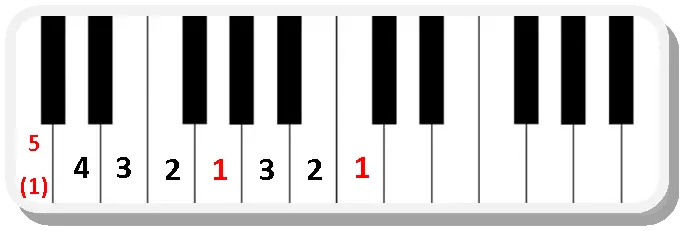
- Use fingers 5-4-3-2-1 on C-D-E-F-G, move the third finger over your thumb and play A-B-C with 3-2-1. This is one octave.
- If you want to continue more octaves, simply repeat the fingering pattern 4-3-2-1—3-2-1.
- Going down again use the same pattern backwards: 1-2-3—1-2-3-4 (repeat as many times you like) and finish on a C with finger 5.
Here is the piano scale fingering for the left hand in 2 octaves:

Piano Scale Exercises To Combine Both Hands
Practice
playing both hands together first in contrary motion. In this way you will use
the same fingering in both hands but with different notes. Fun!
Contrary motion

Parallel Motion
Playing both hands in parallel motion is a bit sneakier, but start practicing like this (watch out for the fingering!):
Piano Exercise 1:

Add on a note!
Piano Exercise 2:
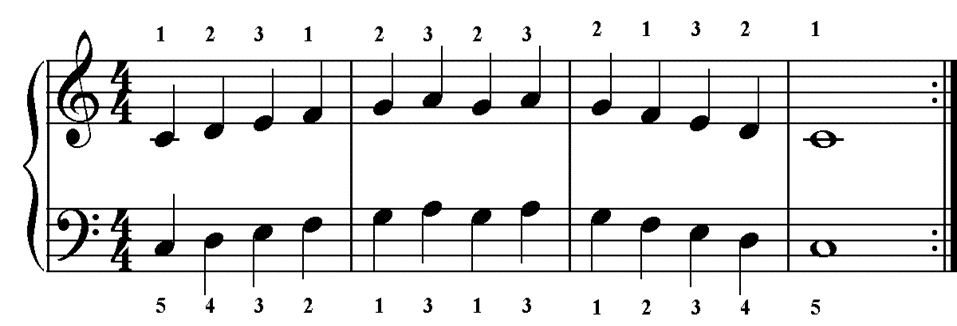
You could repeat the same idea for the descending part of the scale, but here is an exercise that works out that sneaky left hand change after the third finger:
Piano Exercise 3:

Now finish by playing slowly the whole scale with both hands parallel in one octave:

Congratulations! You've just learned to play the C Major Scale!

